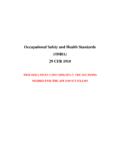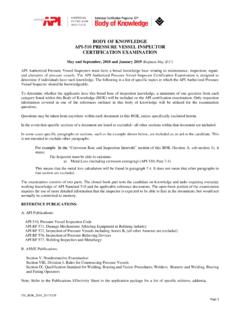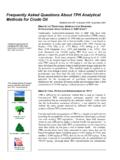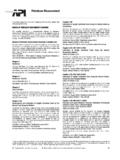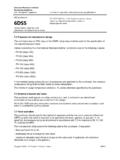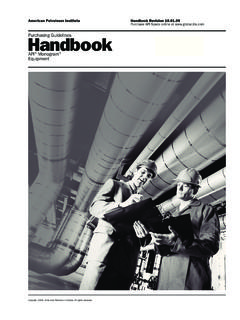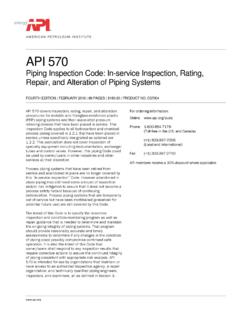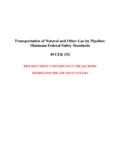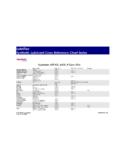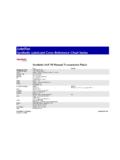Transcription of APPENDIX E—API Base Oil Interchangeability …
1 E-1 December 2016 Version (Reissued 01-03-2017) ANNEX E API base OIL Interchangeability GUIDELINES FOR PASSENGER CAR MOTOR OILS AND DIESEL ENGINE OILS General INTRODUCTION Not all base oils have similar physical or chemical properties or provide equivalent engine oil performance in engine testing. During engine oil manufacture, marketers and blenders have legitimate needs for flexibility in base oil usage. The API base Oil Interchangeability Guidelines (BOI) were developed to ensure that the performance of engine oil products is not adversely affected when different base oils are used interchangeably by engine oil blenders. The API base Oil Interchangeability Guidelines define the minimum prudent physical and engine testing necessary to ensure that engine oil performance is not adversely affected by substitution of one base oil for another. The Guidelines are based on actual engine test data, using different base oils, for both gasoline and diesel engine oil performance.
2 The Passenger Car Motor Oil (PCMO) Guidelines were based on the use of API Service Category SG performance level additive technology and updated for API SH, SJ, SL, SM, and SN quality levels. The Diesel Engine Oil Guidelines were based on the use of API Service Categories CD and CD-II performance level additive technologies and updated for CE, CF, CF-2, CF-4, CG-4, CH-4, CI-4, and CJ-4 quality levels. At these relatively high levels of additive formulation, many of the base oil differences are overwhelmed by the additive performance package. For this reason, these guidelines should not be used to predict equivalent interchange at additive performance levels lower than API Service Categories SH and CD. These Guidelines define the minimum acceptable level of testing for interchanging a base oil that every marketer must perform as a condition for obtaining a license. It is understood that when comparing base stock properties, the precision of the methods listed in Table E-1 is taken into consideration.
3 Use of these Guidelines does not absolve the marketer of the responsibility for the actual performance of the licensed product sold in the aftermarket. The licensee must still ensure all of the engine and bench test results. These Guidelines are subject to modifications based on new data, new or revised test methods, and/or new performance specifications. The current Guidelines must always be used. DEFINITIONS The definitions in through apply to these Guidelines. A base stock is a lubricant component that is produced by a single manufacturer to the same specifications (independent of feed source or manufacturer s location); that meets the same manufacturer s specification; and that is identified by a unique formula, product identification number, or both. base stocks may be manufactured using a variety of different processes including but not limited to distillation, solvent refining, hydrogen processing, oligomerization, esterification, and rerefining.
4 Rerefined stock shall be substantially free from materials introduced through manufacturing, contamination, or previous use. A base stock slate is a product line of base stocks that have different viscosities but are in the same base stock grouping and from the same manufacturer. A base oil is the base stock or blend of base stocks used in an API-licensed oil. base STOCK CATEGORIES All base stocks are divided into five general categories: a. group I base stocks contain less than 90 percent saturates and/or greater than percent sulfur and have a viscosity index greater than or equal to 80 and less than 120 using the test methods specified in Table E-1. E-2 December 2016 Version (Reissued 01-03-2017) b. group II base stocks contain greater than or equal to 90 percent saturates and less than or equal to percent sulfur and have a viscosity index greater than or equal to 80 and less than 120 using the test methods specified in Table E-1.
5 C. group III base stocks contain greater than or equal to 90 percent saturates and less than or equal to percent sulfur and have a viscosity index greater than or equal to 120 using the test methods specified in Table E-1. d. group IV base stocks are polyalphaolefins (PAO). PAOs can be interchanged without additional qualification testing as long as the interchange PAO meets the original PAO manufacturer s specifications in physical and chemical properties. The following key properties need to be met in the substituted stock: 1) Kinematic viscosity at 100 C, 40 C, and -40 C 2) Viscosity index 3) NOACK volatility 4) Pour point 5) Unsaturates e. group V base stocks include all other base stocks not included in group I, II, III, or IV. Table E-1 Analytical Methods for base Stock Property Test Method Saturates ASTM D2007 Viscosity index ASTM D2270 Sulfur (use one listed method) ASTM D1552 ASTM D2622 ASTM D3120 ASTM D4294 ASTM D4927 Note: The most recent version of each of the listed standards shall be used.
6 INTERCHANGE FOR PASSENGER CAR MOTOR OILS GUIDELINES Based on existing engine test data submitted to API, passing engine tests specified in Section are required for interchanging the base stock in an original API-licensed PCMO. In any case where base stocks of more than one group are interchanged simultaneously, the most severe testing requirement applies. Engine testing is not required when a single interchange base stock that meets the definition of group I, group II, group III, or group IV is used at less than or equal to 10 mass percent of the blended PCMO formulation. In some cases, higher percentages of group III or group IV may be substituted without further engine testing as specified in this annex or in the ACC Code ( APPENDIX I, Guideline 5). The ACC Code should be followed for group V. The PCMO blended with the interchange base stock shall meet all physical and chemical specifications and bench test requirements for the appropriate API Service Category and/or ILSAC specification.
7 base stocks approved under the provisions of these Guidelines may be commingled without further testing, consistent with provisions of Annex F. Acceptable test methods for base stock and base oil blend properties are listed in Table E-1. It is understood that when comparing properties, the precision of the methods is taken into consideration. In the following tables, BOV refers to the base Oil Blend Viscosity measured by ASTM D445. E-3 December 2016 Version (Reissued 01-03-2017) For engine oils licensed by API against the ILSAC GF-5 standard, the licensee shall ensure that the ROBO or IIIGA data supporting the final formulation was produced in a formulation containing the pour point depressant and base stock(s) used in the licensed formulation. REQUIREMENTS API recognizes the importance of the Multiple Test Evaluation Procedures. Engine testing to support base oil Interchangeability shall be in accordance with Annex N.
8 These Guidelines shall be used in conjunction with the ACC Code. Complete performance documentation is required for the original Passenger Car Motor Oils (PCMO). The detergent inhibitor (DI) and/or viscosity modifier (VM) remain unchanged when interchange base oils are tested, except as provided by the ACC Code. A base oil interchange obtained under these guidelines applies to a single PCMO formulation. In the event of a change in the DI and/or VM outside the ACC Code, these Guidelines shall be reapplied. For the passenger car tests listed in Table E-2, these Guidelines may allow some testing relief. Check the Guidelines for each specific test before establishing the test program requirements for a specific oil formulation. Table E-2 Tests for API S Category base Oil Interchange Test Name ASTM Annex E Reference SH SJ SL SM SN Energy Conserving Resource Conserving ILSAC GF-5 Sequence IID D5244 X X Sequence IIIE D5533 X X Sequence IIIF D6984 X X X Sequence IIIG/IIIGA/IIIGB D7320 X X X X X Sequence IVA D6891 X X X X X X Sequence VE D5302 X X X Sequence VG D6593 X X X X X X Sequence VIA D6202 X Sequence VIB D6837 X Sequence VID X X CRC L-38 D5119 X X Sequence VIII D6709 X X X X X X Ball Rust Test D6557 X X X X X X EOFT D6795 X X X X X X Filterability - EOWTT D6794 X X X X X Homogeneity & Miscibility D6922 X X X X X X TEOST 33/33C D6335 X X TEOST MHT D7097 X X X X Aged Oil Low Temp.
9 Vis. ROBO D7528 X X Elastomer Compatibility Std. Ref. Elastomers D7216 X X Note: X = Test methods where BOI is defined. Testing requirements can be found in API 1509 Annexes G and Q and/or ASTM D 4485. Passenger car engine tests required for interchanging the base stock are given in through The BOI Guidelines vary according to the API base oil group and amount of the base stocks used in the original test oil and the candidate oil formulations. All percentages are mass percent of the total formulation unless otherwise noted. The data set used to establish the BOI Guidelines involving group III base oil is based on a base oil VI range up to 126 VI, within the precision of the test. E-4 December 2016 Version (Reissued 01-03-2017) For Sequence IIIE, IIIF, IIIFHD, IIIG and IIIGA tests required for interchanging the base stock, specific requirements are given in Table E-3. Single Technology Matrix (STM) is an alternate approach to BOI for Sequence IIIF, IIIFHD, IIIG, and IIIGA (see Annex R).
10 Additionally, once five passing IIIGB tests have been demonstrated on a unique technology (a Unique Technology is a single additive package (DI) at a constant treat rate), then no additional sequence IIIGB testing is required for that unique technology. Table E-3 Sequence IIIE, IIIF, IIIFHD, IIIG, IIIGA and IIIGB Tests Required for Interchanging the base Stock base Stock in Original Test Oil Interchange base Stock group I group II group III group IV group V group I Required Required 30% Not Required ----- > 30% Required 30% Not Required ----- > 30% Required Required group II Required Required 30% Not Required ----- > 30% Required 30% Not Required ----- > 30% Required Required group III Required Required Required 30% Not Required ----- > 30% Required Required group IV Required Required 30% Not Required ----- > 30% Required Not Required provided the interchange group IV meets the original manufacturer s specifications in all physical and chemical properties Required group V Required Required Required Required Required For Sequence IVA tests required for interchanging the base stock, specific requirements are given in Table E-4.
